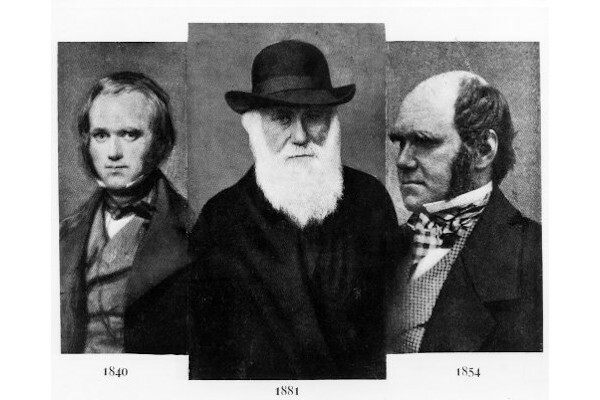Charles Robert Darwin was an important naturalist, born in the day February 12, 1809, in England, more precisely in the city of Shrewsbury. This important researcher, from a very young age, already demonstrated his love for science, dedicating himself to his collections and carrying out experiments, with his brother, in a chemistry laboratory.
Darwin was known for his constructionsThe origin of species, which contributed to the understanding of the evolution and today it is considered one of the most influential scholarly books in history.
Read too:Evidence of biological evolution - mind map
Darwin Biography
Darwin was born into a wealthy, traditional and religious family, and was the son of Robert Waring Darwin (1766-1848) and of Susannah Wedgwood (1765-1817). He had three sisters and a brother. His mother passed away when he was just eight years old. From an early age he was interested in nature and all the phenomena that occurred in it. He was always a great collector, and during his childhood he learned to fish and hunt.
Formation
As a young man, at age 16, Darwin started medical school, following a family tradition. However, during classes, especially those in which he would have to undergo an operation without anesthesia, he discovered that it was not what he had dreamed of for his life, and he dropped out of the course. Despite this, at that time, he was able to meet some important people for your professional growth.

After dropping out of the course, Darwin was sent by his father to Cambridge University to study Bachelor of Arts and become cleric of the Anglican Church. At that moment he met John Stevens Henslow, a naturalist dedicated to botany. This researcher was important in Darwin's life, as he was the one who appointed him to join the crew of the HMS (Her Majesty Ship) Beagle, a ship that would make a great trip passing through various regions of the world.
Darwin boarded the Beagle on December 27, 1831, and for five years, collected and observed different forms of life around the world, better understanding the changes that have occurred in the species. the naturalist too collected fossils and made geological observations that allowed him to observe the supposed evolution that the species would have undergone over time.
One of the important points of this trip was the stop atGalapagos Islands. Darwin realized that each island had a group of endemic birds and that this specificity was probably related to the characteristics of the environment where they lived. Such analysis was important to understand the natural selection process proposed by him later.
Wedding
Darwin married, in 1839, with Emma Wedgwood, his first cousin, with whom he had 10 children. Of the 10 children, three died in infancy, the most striking death for Darwin being that of his 10-year-old daughter Annie.
Death
Charles Darwin died in April 19, 1882, probably from a heart attack. Although his ideas were radically criticized by the Church, he was buried in Westminster Abbey, near Isaac Newton.
Do not stop now... There's more after the advertising ;)
The origin of species
When Darwin returned to England after his trip aboard the Beagle, he had understood that the species underwent changes over time. However did not immediately publish his perceptions, mainly by religious issues. At first, his publications were focused on the fauna and flora of the places he visited during the trip.
In 1958, Darwin received a letter from Alfred Russell Wallace, and realized that the naturalist had reached the same conclusions as he. This letter urged him to write his work as quickly as possible. However, the book's launch did not take place immediately, and, with the help of Hooker and Lyell, two researchers and their friends, Darwin and Wallace presented their articles on the same day, thus preventing him from publishing his theory.
THE main work of Darwin, known as The origin of species through natural selection,was published a year later, in 1859. It was later renamed with its best-known title: The origin of species. The book was a sales success, however, the theory was not well accepted, especially by the religious.
Read too: Lamarckism - evolutionary theory proposed by Lamarck
Natural Selection Theory
In his main work, Darwin proposed that evolution would occur thanks to the mechanism known as natural selection. According to this theory, living beings, at all times, would be struggling to survive in the environment, and the middle would be responsible for selecting the fittest to survive in it. Thus, the individual who survives and reproduces would pass on his characteristics to his descendants, and, over time, the advantageous characteristics would remain.

The figure above shows an example of how natural selection takes place. In it we observe a fox and several white and black rodents. At first, white rodents present themselves in greater amount than black rodents. However, those have a disadvantage in relation to these: they are more easily seen. This causes the fox to capture more white individuals than black ones. Over time, we observed a situation different from that observed in the beginning, with a greater number of black rodents now.
Read too: Types of natural selection - directional, stabilizing and disruptive
In this situation, we found that white rodents were less able to live in that environment, as they did not have the ability to camouflage like black ones. These, then, died later and were able to reproduce, passing their characteristics to their descendants. In this example, it appears that the environment selected the black rodents.
Darwin's proposed natural selection provided us with a lot of important information on how species changed over time. However, Darwin was not able to explain how the characters were inherited. These explanations were only possible after the development of genetics. If you are more curious about the topic, read our text: What is natural selection?
By Vanessa Sardinha dos Santos
Biology teacher


